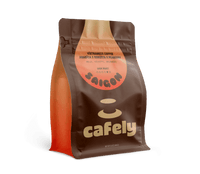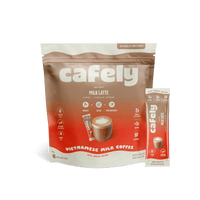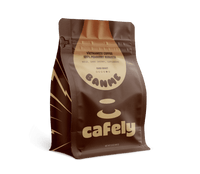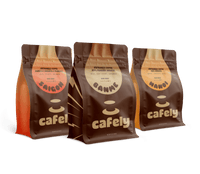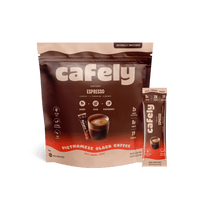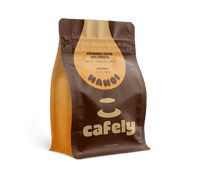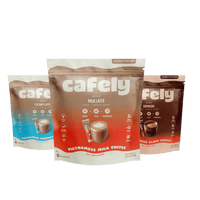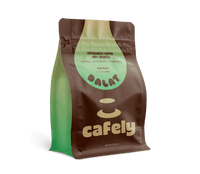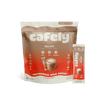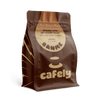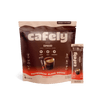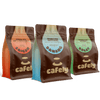Flat white and macchiato — it’s easy to mix them up. Both are simple coffee drinks made with espresso and milk. But they couldn’t taste any more different.
One gives you a smooth, creamy sip with mellow coffee flavor. The other stays bold and intense with barely any milk. It all comes down to the milk amount, texture, and strength.
We’ll break it all down step by step, so you’ll know exactly which drink suits your taste before your next coffee shop order.
Quick Summary: Flat White & Macchiato (Differences)
The key difference comes down to milk and flavor strength.
- The flat white combines espresso with lots of steamed milk and a thin layer of microfoam on top. The milk makes the coffee smooth, creamy, and balanced.
- The macchiato is the stronger option. It’s espresso “marked” with just a small spoonful of milk or foam. The milk doesn’t change much; it only softens the bitter notes of the coffee.
Flat White vs Macchiato: Flavor & Strength

The way these drinks taste could not be more different. You get two completely separate experiences, all because of the amount of milk.
1. Flat White
A flat white feels smooth and velvety from the first sip. It starts with rich espresso but adds a generous amount of steamed milk.
The milk doesn’t just cool down the espresso. It completely transforms it into a creamy, mellow drink. You still taste the coffee, but it’s softer, well-balanced, and easy to sip. People often describe it as a gentle cappuccino without any bitterness.
2. Macchiato
A macchiato delivers the exact opposite. It’s bold, intense, and direct. The word “macchiato” means “marked” in Italian, and that’s what happens — the espresso gets marked with just a tiny bit of milk or foam. This drink keeps the strong, sharp flavor of pure espresso. The small amount of milk only cuts the bitterness slightly, making each sip rich and punchy.
Choosing the Best One For Your Taste
If you enjoy a smooth, creamy drink that balances espresso flavor, the flat white works best. If you prefer a strong, concentrated brew, go for a macchiato. It’s sharp, short, and ideal when you want to taste the coffee itself without much milk softening the flavor.
Coffee-to-Milk Ratio: How Much Milk Is in Each Drink?
The amount of milk changes everything in these two drinks, from flavor to strength and texture.
Flat White Milk Ratio
A flat white has a high milk-to-coffee ratio. Most recipes use about ⅓ espresso and ⅔ steamed milk. This means you always get more milk than coffee in every cup. But it’s not just plain milk, it’s milk steamed into silky microfoam. Microfoam has tiny, smooth bubbles that blend perfectly into the espresso without creating a thick foam layer. This makes each sip smooth, velvety, and balanced, with no heavy foam sitting on top.
Macchiato Milk Ratio
A macchiato uses barely any milk — just one to two teaspoons of milk foam. The milk foam sits right on top, “marking” the espresso without changing its body. Because of this, a macchiato stays dry, light, and highly concentrated. It doesn’t feel creamy. It feels sharp and focused, letting the espresso flavor lead.
How Milk Affects Flavor & Experience
Why does this matter? The milk doesn’t just change texture. It affects the entire experience.
A flat white feels richer, heavier, and smoother because of the steamed milk. It turns espresso into a comforting, café-style drink you can sip slowly.
A macchiato feels lighter but stronger. The small amount of milk doesn’t stretch the drink. You finish it fast and get a quick, strong coffee hit with enough creaminess to cut out the espresso’s bitter edge.
Flat White vs. Macchiato: Size & Serving Style
Size changes how you drink and enjoy your coffee. It controls how long your drink lasts and what it feels like to finish it.
The serving size provides different experiences:
- Flat white — Larger. Longer, more relaxing drink.
- Macchiato — Smaller. Short, quick caffeine hit.
Flat White Serving Size
A flat white is served in a five to six-ounce ceramic cup. Some cafés may stretch it to eight ounces, but the classic version stays smaller than a latte. The cup keeps the drink warm longer, while the smooth milk encourages you to sip slowly. It’s the type of drink you enjoy while relaxing, maybe with breakfast or during a quiet break.
Macchiato Serving Size
A macchiato is tiny on purpose. It’s served in a small two to three-ounce demitasse cup — the same cup used for espresso shots. There’s no sipping for long here. You drink it fast, usually in two to three sips, and feel the strong espresso flavor hit immediately. Macchiatos are perfect when you’re in a hurry but want something more than plain espresso.
Flat White vs Macchiato: Which Has More Caffeine?

Both drinks use the same base — a kick of espresso. That means their caffeine content depends almost entirely on how many espresso shots you use.
Most cafés serve a single shot in a macchiato and one or two shots in a flat white. At home, you can also choose how many shots you prefer. On average, one shot of espresso contains around 63 mg of caffeine. If your flat white has two shots, it will have more total caffeine than a single-shot macchiato.
The strength you taste and the actual caffeine content are not always the same.
Both drinks can have the same caffeine amount, but the macchiato feels stronger because it’s less diluted.
Flat White Caffeine Content
A flat white feels smoother, even when it has the same amount of caffeine. The steamed milk and microfoam stretch out the drink, making the flavor more mellow and easy to sip. You still get the same caffeine boost, but the drink feels lighter and more comforting.
Macchiato Caffeine Content
A macchiato feels much stronger because it contains almost no milk to soften the taste. The flavor hits you immediately. There’s no dilution, no mellow aftertaste, just bold, sharp espresso in every sip. Even if the caffeine amount is the same, you feel the coffee more intensely in a macchiato because it’s more concentrated.
Best Coffee Beans for Flat White and Macchiato
The type of coffee beans you use completely changes how both drinks taste. Espresso is strong, but milk changes flavor in different ways. That’s why choosing the right roast level and bean blend makes a big difference, especially when milk is involved.
Best Coffee Beans for Flat White
A flat white uses more milk, so you need beans that stay flavorful without being too sharp. The best choice here is medium to dark roast arabica beans. These beans bring out smooth, rich notes like chocolate, caramel, and nuts. They blend perfectly with steamed milk and microfoam, creating a balanced, creamy cup.
If you want to make a classic flat white at home, we recommend Cafely DaLat. It’s made from 100% arabica beans grown in the cool mountains of Vietnam. The flavor is smooth, mild, and lightly sweet, which pairs beautifully with milk.
If you like a stronger, deeper flavor in your flat white, you can try the Cafely DaNang Blend. This blend combines arabica and robusta beans, giving you darker notes of nuts, wood, and a little earthiness. It makes a stronger flat white, perfect if you enjoy a bolder taste with a creamy finish.
Best Coffee Beans for Macchiato
Macchiatos are espresso-forward, so the bean choice must focus on boldness and clarity. Here, you want strong espresso blends or single-origin beans with deep, intense flavors. The small amount of milk in a macchiato won’t hide the bean’s character, so it’s important to use something that holds its strength.
For a macchiato, a darker roast works well. You can use single-origin espresso with rich chocolate or dark fruit flavors, or go for a blended espresso that gives you depth and balance.
We recommend going for a dark roast arabica, such as DaLat, or a well-balanced blend such as Saigon OG. This blend is crafted to be intense yet smooth, making it a great fit for both macchiatos and flat whites. It offers a bold flavor with balanced richness, so you’ll get a strong punch in a macchiato and a creamy depth in a flat white.
If you prefer quick and easy preparation, Cafely Instant Espresso also works well. It’s designed to give you a robust, authentic espresso flavor, perfect for both drinks, without needing an espresso machine.
Make a Flat White at Home

A flat white is all about smooth texture and mellow flavor. The key is combining rich espresso with silky, steamed milk.
Here are three simple steps to make a flat white at home:
Step 1: Brew 1 to 2 Shots of Espresso (3 minutes)
Brew an espresso shot into a large coffee mug using an espresso machine, moka pot, or Cafely Instant Espresso. If you prefer a smoother, milkier beverage, brew a single shot. For a stronger cup, go with two shots.
Step 2: Steam the Milk and Create the Microfoam (4 minutes)
Pour four to five ounces of milk into a milk pitcher. Whole milk gives you the richest, creamiest result, but oat or almond milk also works.
Use a steam wand or milk frother to warm and froth the milk. Froth until a smooth, glossy texture is achieved with a fine microfoam on top.
Step 3: Pour the Milk Over the Espresso Slowly (1 minute)
Slowly pour the milk over your espresso, starting in the center and finishing with a thin, velvety layer of foam on top. Pour until the foam is level with the rim of the mug — this is what makes it a “flat white.”
Your flat white should feel creamy, smooth, and perfectly balanced, without tasting too milky.
Make a Macchiato at Home
A macchiato is for you if you love bold coffee flavor with a touch of milk. It’s fast, strong, and easy to make.
Here’s how to make a macchiato at home:
Step 1: Brew a Single Shot of Espresso (3 minutes)
Brew a single or double shot of espresso. If you don’t have an espresso machine, Cafely’s Instant Espresso works well. However, for the best results, opt for a freshly brewed espresso made from whole-bean coffee.
Step 2: Froth a Small Amount of Milk (2 minutes)
Froth a small amount of milk in a pitcher. You only need about two to three tablespoons, but you’ll need to stream more than needed to create the foam. Steam the milk until warm, light, and velvety. Aim for a soft, airy microfoam.
Step 3: “Mark” the Espresso with Milk Foam (1 minute)
Using a teaspoon, scoop a small amount of microfoam and place it on top of the espresso. You’re not mixing it in, just “marking” the drink with milk.
The result is a bold and punchy espresso with just enough milk to soften its bitter edge.
FAQs: Flat White vs Macchiato
Here are detailed answers to the most common questions about flat whites and macchiatos.
1. Is A Macchiato Stronger Than A Flat White?
A macchiato tastes stronger because it contains very little milk, which keeps the espresso flavor bold and intense. However, the caffeine content is the same in both beverages.
2. What Is The Closest Drink To A Flat White?
The closest drink to a flat white is a cappuccino, which also combines espresso with milk. The cortado — a Spanish espresso drink — is also similar, but it uses a 1:1 milk-to-coffee ratio.
3. Is A Flat White The Same As A Cappuccino?
No, a flat white is not the same as a cappuccino because it has a thinner layer of microfoam and more steamed milk, making it smoother and less frothy.
4. Is A Flat White The Strongest Coffee?
A flat white is not the strongest coffee. Vietnamese robusta coffee is considered to be one of the strongest, alongside the Italian ristretto — a “restricted” espresso that’s about twice as concentrated.
5. What Is A Dirty Flat White?
A dirty flat white is a version of the flat white where a shot of hot espresso is poured over cold iced milk, creating a refreshing iced coffee drink with rich espresso flavor.
6. What Is The Strongest Coffee With Milk?
The strongest coffee with milk is usually a macchiato or a cortado because both contain a high ratio of espresso to milk, allowing the bold coffee flavor to stay prominent with minimal dilution.
7. What Is A Skinny Flat White Coffee?
A skinny flat white is made with skim milk instead of whole milk, which reduces the overall calories and fat content while keeping the drink’s smooth, creamy texture.
8. Why Do Flat Whites Cost More?
Flat whites often cost more than other milk-based drinks because they usually contain two shots of espresso and require more precise milk texturing, which takes extra time and skill from the barista.
9. What’s The Difference Between A Latte And A Macchiato?
The main difference is that a latte contains a much larger amount of steamed milk, making it a milder and creamier drink, while a macchiato contains almost no milk, keeping the espresso flavor strong and bold.
10. What is the Strength of a Macchiato?
A macchiato is one of the strongest milk-based coffee drinks because it uses just a small amount of milk or foam to slightly soften the espresso, allowing the full strength of the coffee to come through.
